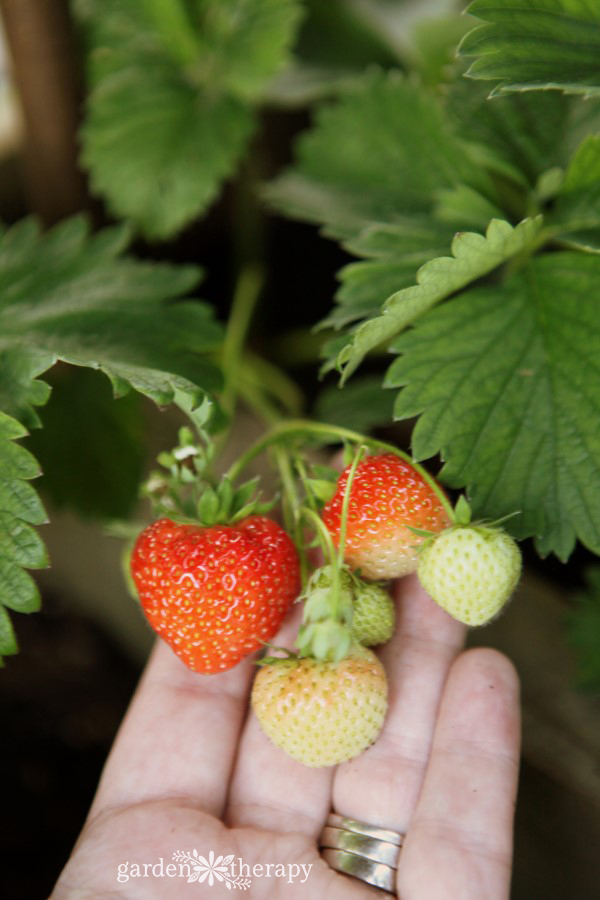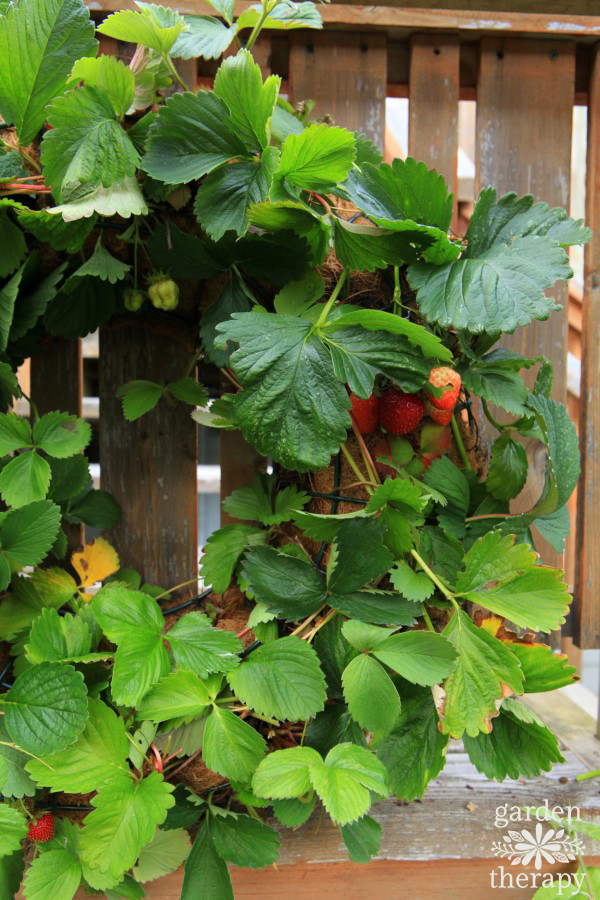Growing strawberries is simple and absolutely delicious! Learn four different methods you can choose from when learning how to grow strawberries, plus what to do with them once you harvest.

There’s nothing quite like biting into a freshly grown strawberry. Plucked right off the vine, they are warm from the sunshine and perfectly ripened with that beautiful red color. I can taste it now!
Here’s everything you need to know about growing strawberries, plus what to do with them once you harvest!
How to Grow Strawberries: 4 Methods
If you have only ever eaten strawberries out of a plastic supermarket box, I’ve got great news for you! Growing strawberries is simple, and the result is a thousand times better than anything you could buy.
Keep in mind, that no matter how you choose to grow strawberries, you need about 6 plants per person to make the harvest worth the effort. It’s totally doable though, because you can pack a lot of plants into unique grow bags, hanging baskets, and containers to maximize the surface area of these plants. They don’t need much room for roots so as long as there is soil space in your design, you can grow strawberries the smart way.
I’ll show you exactly how to grow strawberries in four different ways, and some tips and tricks to get the best harvest ever.
1. Grow Strawberries in Hanging Baskets

Did you know that you can easily start growing strawberries in a hanging basket? It’s true! You can use any hanging basket that you have or even convert a vintage egg basket by lining it with some moss. You can only fit a few plants in here, so you need a few of them or they will mostly be decorative snacking berries.
You can also plant a ton of strawberry plants in one of these crazy grow bag-style hanging planters. This one is meant for annual flowers, but you can find grow bags like these that have pockets made for strawberries and it sure produces a lot of fruit in a tiny space!

I like gardening in hanging baskets for a couple of different reasons.
First of all, a hanging basket planting can help your strawberries drain properly and avoid overwatering. It’s also helpful for avoiding root rot since the water drains out rather than sits.
Secondly, growing strawberries in hanging baskets get your fruit out of reach for many pests.
This is especially handy if you live in an area with a rabbits or deer. Those cute little critters love to munch on strawberries—and can we really blame them? Remove temptation and save your harvest by lifting them high out of their reach.
Here’s an entire post about how to grow strawberries in a hanging basket, as well as many other fruits, herbs, and vegetables.
2. Grow Strawberries in Pots

Growing strawberries in pots are one of the most classic ways to grow this tasty berry. There’s no wonder it’s so popular – with this method you get to enjoy the flowers from the strawberry plant and then the berry itself in a portable package!
You certainly can use a strawberry pot or a tiered container to grow strawberries in. You can grow them in a regular pot of course, but the design of the pots with multiple holes for small plants allows a much larger harvest.
I like to add a watering tube in the middle of my strawberry pots, to make sure that the water gets all the way down to the bottom soil evenly. You can add one by drilling a few holes in PVC pipe and then filling it with sand to slow the water release.

Want to learn all about how to grow berries in pots? I’ve got you covered! Here’s everything you need to know about growing strawberries in containers.
3. Growing Strawberries in a Raised Bed
A raised garden bed or planter makes an excellent spot for growing strawberries. You may have seen tiered strawberry raised bed designs where multiple levels are built as steps up the bed to fill lots of strawberry plants in a small space. You could build one, or buy a premade pyramid raised bed like this one.

My friend Tanya from Lovely Greens had the great idea to take a single pallet and turn it into a beautiful, functional strawberry planter. I really like this idea because it’s a great way to upcycle, and it also allows plenty of room for those runners to poke out through the slats.
Watch her video here – her strawberries look amazing!

4. Grow Strawberries in the Ground
If you have the space, this is a great way to get a good harvest of one of my favorite fruits. These sturdy plants thrive planted in the ground where they have plenty of room to grow out their runners.
They also make tasty, pretty edible edgings, or you can let them vine out and spill over a garden wall or fence. I like to pop them throughout the garden as they are decorative as ground covers.

You can see them here in my garden among plants like oregano, blueberries, lemon verbena, and ajuga looking pretty and flowering well in April.
Tips for Growing Strawberries

Growing strawberries is not as tricky as you might think! In fact, when properly planted and cared for, you can enjoy a bountiful harvest for a couple of years before needing to remove the mature plants.
Here are a few tips to help you learn how to grow strawberries even if you have never grown them before.
Plant Early Spring / Early Fall
Strawberries are one of the first cool climate fruits to be ready to harvest, because the plants can tolerate cool temperatures and light frost. New plants can be planted in early spring. Usually they are sold as bare root runners, and once you have a good supply, they will send out runners you can plant to increase your crop.
Soak the roots when you get them to re-hydrate them, about 20 minutes is good, then dig them into well amended soil rich with compost and organic matter. Space them 18″ apart.
In the fall, gather the runners and dig them into the garden where you want berries and they will overwinter as perennials in Zone 5-8, and can be planted as annuals elsewhere.
Give Room for Runners
Strawberries are a plant that propagates through runners. Runners mimic the look of vines with little strawberry plants attached to the end, similar to indoor spider plants. These runners help strawberries spread outwards.
To avoid over crowding, lots of surface soil is needed for a strawberry patch so you can plant the runners in between the mature plants. As the mature plants stop producing, the young plants will take their place.
When you grow strawberries from seeds, which is absolutely a possibility as well, space you’ll want to plant them at least 18″ apart from each other.
 Plant Somewhere with Plenty of Sun
Plant Somewhere with Plenty of Sun
Berries tend to enjoy sunny spots, and strawberries are not an exception. Whichever method you choose for planting your berries, make sure to place them somewhere with eight hours (or more!) of sun for the best harvest and sweetest berries. The plants will tolerate a bit of shade, but the berries will be fewer and bland. You need good sun for stellar fruit!
Amend Your Soil Properly
You’ll need slightly acidic soil for strawberries to thrive—about 5.5-6.8 pH is ideal. If you have no idea what your pH balance is, you can easily do a soil test right at home and find out.
Fertilize and Water Properly

All that time hanging out in the sun can leave your little berries thirsty! While it’s important not to overwater, you’ll want to make sure they get 1-1.5 inches of water weekly.
Avoid getting the leaves wet—instead, make sure the water gets to the root system underneath.
To keep the plants happy, add a nitrogen-rich, organic fertilizer in the early spring and again in the fall.
Companion Plant with Care
Companion planting can help your strawberries thrive, or if done improperly can hinder their growth. I recommend growing strawberries alongside garlic, beans, lettuce, spinach, or peas. They also play nicely with thyme.
Strawberries, just like most other fruit and vegetables, should not be planted alongside fennel. Additionally, strawberries do not do well with veggies in the brassicas family, so plant your cabbage or Brussels elsewhere!
How to Harvest Strawberries
Once your berries are ripe, red, and ready for harvest, you’ll want to take care to pluck them in the early morning. The fruit should still be slightly cool once you remove it from the vine, then you’ll need to refrigerate immediately.
Plus, you can also save certain strawberry seeds for your next planting!

How to Use Homegrown Strawberries
If you are blessed with a bountiful harvest, there are so many ways you can use up your berries. Here are some of my favorite ideas.
#1 Make an Infused Strawberry Vinegar
Infused vinegar sounds fancy, but it actually is quite simple to make. You simply load up a mason jar with simple ingredients such as your homegrown strawberries, vinegar, and herbs, then let it infuse for about ten days. Easy!
Learn how to infuse vinegar with strawberry here.

#2 Create a Living Strawberry Wreath
If you have extra strawberries growing that need to be relocated, try making this simple living strawberry wreath. It’s pretty and practical as your berries will continue to grow.

#3 Make an Easy, Low Sugar Strawberry Freezer Jam
If you have never made jam before, this freezer jam recipe with strawberries is the perfect place to start! It takes minutes to make and lasts for up to a year when stored in the freezer.


 Plant Somewhere with Plenty of Sun
Plant Somewhere with Plenty of Sun


What to do with plants in pots when they have finished fruiting?
Thanks to you have fresh strawberries, I new i could count on you
Are you supposed to cut the runner so they don’t take away from the main plant?
That’s how I understand it 🐸. First year of the plant your also supposed to pick the flowers of to ensure a big, healthy plant once allowed to fruit ☀️